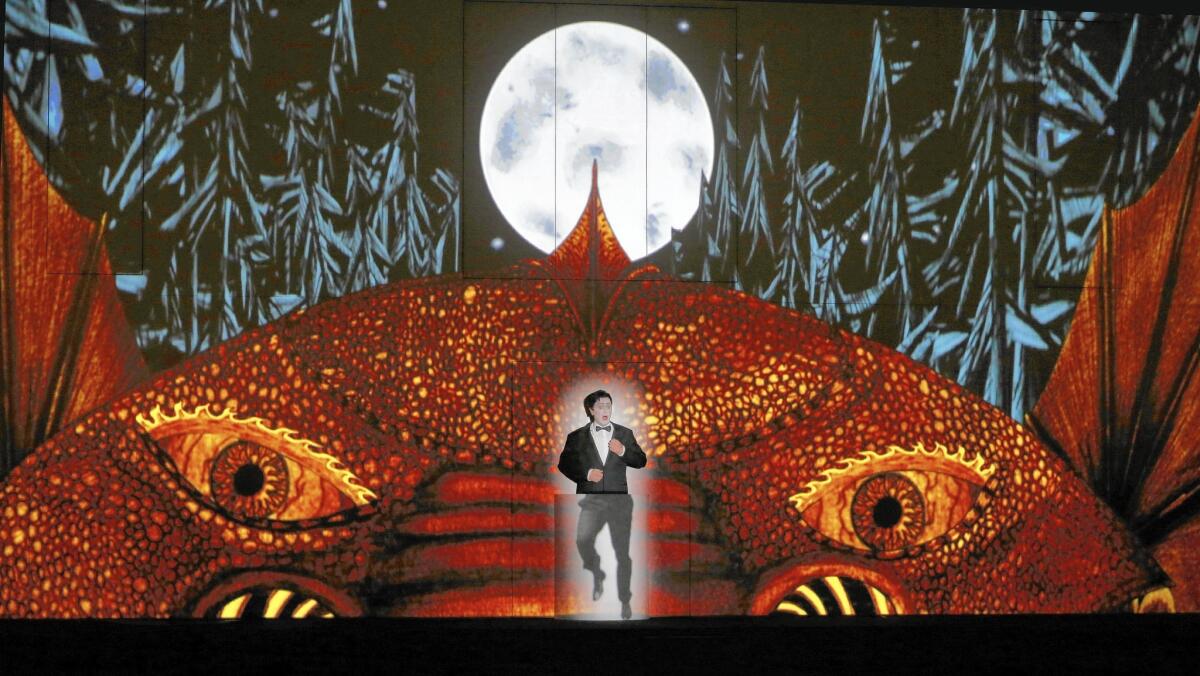Review: L.A. Opera again casts an enchanting spell with its silent-movie-styled ‘ Magic Flute’

Barely two years after Los Angeles Opera first mounted Barrie Kosky and Suzanne Andrade’s popular silent-movie take on Mozart’s “The Magic Flute,” the company brought it back to the Dorothy Chandler Pavilion on Saturday night.
L.A. Opera knows a hit when it sees one.
The cast is different, but James Conlon once more conducts, and the show remains a delight. The show is what it is. Live singers are ingeniously incorporated onto what looks like a movie screen that includes aspects of live action along with Paul Barritt’s fanciful animation.
SIGN UP for the free Classic Hollywood newsletter >>
A delight, and yet there is also cause for fret. Given a season of six main stage operas, that’s too soon. For the first half of 2016, L.A. Opera is mounting only this and two ubiquitous Puccini operas — “Madame Butterfly” and “La Bohème.”
Still, the Kosky-Andrade “Flute” is a remarkable achievement. It is fun for the whole family (at least by opera standards). And we can look forward to less broken-record programming next season.
The new cast, which features no-name singers and offers several young singers their first major roles with the company, changes things very little. This is a “Flute” of visuals first and music second. A singer in this production can’t really make a big impact, but a singer can ruin things very easily.
That is because for significant parts of the opera, all you get of the live Tamino or Papageno or Queen of the Night is a head protruding from trap doors on the flat backdrop, onto which the film is projected. The cast’s challenge is to stay in lockstep with the movie, yet sing. Everyone is a cog in a machine. There is small room for improvement, but the machine basically runs smoothly.
What a machine. The silents are evoked. Pamina, the love interest, could be Louise Brooks as Lulu. Papageno, the humorous bird catcher, is a slapstick character, maybe a German version of Harold Lloyd. The Queen of the Night is a giant spider. Lustful Monostatos is Nosferatu. The top-hatted cultish Sarastro looks as if he could be Georges Méliès, the first pioneering French filmmaker.
There are cute cartoon characters on stage. You don’t want to know too much about that before seeing it. The “Flute” is a singspiel, an opera with spoken dialogue instead of sung recitatives, and a lot of silly German dialogue can be a chore for American audiences, even with titles, and for German audiences too. The silent-movie approach means that can be taken care of with titles and the melodramatic effect of Mozart’s D-Minor Fantasy played on an amplified fortepiano.
There are some disadvantages to this that will trouble some more than others. The production is funny, but the comedy is no longer Mozart’s. The funny stuff is on screen, rather than truly operatic. This hurts Papageno the most. He is mostly just running, rather than being his goofy self. This also means that some of the profound spiritual underpinnings of the “Flute” don’t make it to the flat screen.
In fact, the production comes most to life on the rare occasions where you actually have a singer standing in front of the backdrop, rather than just popping out of it. When Pamina, silhouetted in the snow, sings movingly of losing her love, suddenly Norwegian soprano Marita Solberg seemed real and her voice blossomed beautifully. Only then could you tell that this was an impressive debut with the company.
Happily, most in the cast got a couple of similarly real moments (or seconds). Among those young singers working their way up through the company was Ben Bliss, an ever-elegant and solid Tamino; So Yong Park overcame initial uncertainty to become a stunning Queen of the Night;
Jonathan Michie’s strong baritone created an unusual virile Papageno; Brenton Ryan offered deliciously hammy Monostatos, the vampire. Only Wilhelm Schwinghammer, a German bass in his L.A. Opera debut, seemed not entirely comfortable with either his surroundings or Mozart’s music.
The Three Ladies were L.A. Opera regulars as well. Peabody Southwell, whose star should soon rise, turned the third of the ladies into something more than a bit part. The three boys were, as required, adorable.
Conlon’s job was to fit everything to the film, make contact with distracted singers and dig as deeply he possibly could into Mozart’s orchestral score. He did all three.
So, yeah, see it. And see it now. With luck, this “Flute” (or any “Flute”) won’t be back any time soon. There are too many other Kosky productions to catch up with, to say nothing of the long list of operas the company has yet to mount.
------------
‘The Magic Flute’
Where: Dorothy Chandler Pavilion, 135 N. Grand Ave., Los Angeles
When: 7:30 p.m. Saturday, Feb. 24 and March 2; 2 p.m. Feb. 28 and March 6
Tickets: $139-$374
Info: (213) 972-8001 or www.laopera.org
Running time: 2 hours, 40 minutes (one intermission)
------------
For the Record
Feb. 16, 12:43 p.m.: An earlier version of this article contained an incorrect phone number for L.A. Opera.
More to Read
The biggest entertainment stories
Get our big stories about Hollywood, film, television, music, arts, culture and more right in your inbox as soon as they publish.
You may occasionally receive promotional content from the Los Angeles Times.











